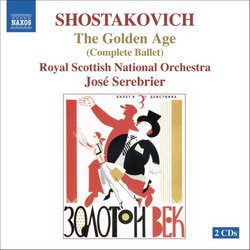Sassy and Superior Shostakovich: Grab It!
J Scott Morrison | Middlebury VT, USA | 12/07/2006
(5 out of 5 stars)
"In 1930, shortly after Shostakovich returned to Soviet Russia from his first extended trip to Western Europe he composed the score for a ballet that came to be called 'The Golden Age' (or, as it is often translated into English, 'The Age of Gold'). During his sojourn he had been much influenced by his exposure to jazz, to the cabaret-style music of 1920s Berlin, and to the spirit of 'I don't care' encountered in jazz age Europe. The evening-long ballet was premiered in late 1930 in Leningrad and although it had a respectable run, it was not a great success largely because the choreography was, according to some, inept. The plot of the ballet was supposedly a satirical look at capitalist Europe vis-à-vis communist Russia. It depicts the triumphant exploits of a Soviet soccer team visiting an industrial exposition, 'The Golden Age of Industry', in a Western city called simply 'U-town.' The plot was also seen as a satire of the disarmament conference in Geneva. Certainly the music Shostakovich provided was satirical in the extreme. Interestingly the ballet has since been revived at least a couple of times with a completely different narrative (without the soccer team) and with different choreography.
Fortunately, the ballet music works perfectly well as a stand-alone work. The present recording presents the work in its final form as approved by Shostakovich; we are told (but I have not been able to verify this) that this is the first such complete recording. José Serebrier certainly has the measure of the music. He dives right in and gives us almost 2 1/2 hours of sparkling vintage Shostakovich. Most familiar, of course, is the 'Polka' (subtitled 'Once Upon a Time in Geneva') from Act III. This two minute piece is surely one of Shostakovich's most familiar works, having been transcribed for all manner of ensembles. It was the very first music I ever heard by Shostakovich, back in the 1940s, when the composer was so poorly known in the US that the musician who introduced me to it pronounced the composer's name as ShosTOCKovich. I remember being absolutely charmed, and a little puzzled, by the composer's wrong-note style and ebullient rhythms. Another excerpt from the ballet is the somewhat less familiar arrangement of Vincent Youman's 'Tea for Two' that Shostakovich called 'Tahiti Trot.'
Most of the music in the ballet goes at a fairly fast tempo and Serebrier makes the most of this, moving the many short individual pieces right along. The result of this is that the ballet comes across as cheeky, satirical, good-humored and endlessly inventive. Frankly the only passage that I thought fell a little flat (and I suspect this is more the fault of the composer than the present performance) is the ten-minute section in Act I called 'Dance of the Diva.' On the other hand, there are so many delightful sections that the diva's adagio is soon forgotten. For instance, there is 'The Supposed Terrorist', which features a flexatone in an oily waltz, or 'The Football Match' which begins with a referee blowing an actual whistle and which depicts the Soviet team mopping up the playing field with their opponents, or the sly 'Everybody amuses oneself in one's own way' in Shostakovich's trademark side-slipping harmonies. The entire Scene 5 of Act III, called 'Music Hall Divertissement' (and which contains the 'Polka' as well as a Tap-Dance, a Tango and rumbustious Can Can) is too delicious for words. The ballet ends with the Soviet system triumphing over that of Western capitalism, but one can hear in the orchestra that the triumph is overtinged with bombast and wishful thinking.
Serebrier and the Royal Scottish National Orchestra cannot be praised highly enough. This is a superior performance with vitality and just the right touch of sly humor. They are given lifelike sound by producer Tim Oldham and engineer Phil Rowlands. I was also delighted to find the names of all the RSNO players listed in the CD's booklet; they deserve the recognition.
This is definitely a set to grab.
Scott Morrison"
A combination of cheeky fun and musical wallpaper
Santa Fe Listener | Santa Fe, NM USA | 03/17/2007
(4 out of 5 stars)
"Between them Mr. Morrison and the Amazon reviewer have covered everything that needs to be said (and more) about Shostakovich's cheeky first ballet, The Age of Gold. Even in 1930 the anti-bourgeois, anti-capitalist rhetoric of the scenario was tiresome, so it helps to ignore it. I concentrated instead on the jazzy parts of the score, which are supposed to portray Western decadence but turn out, naturally, to be a lot more fun than the virtuous music assigned to our heroic Soviet soccer players. There are some seriously modernist, dissonant sections as well; we are in Shostakovitch's manic-depressive emotional world, after all.
I wish I could second the other reviewers in calling this very long ballet a thrilling romp. To my ears, though, there's a lot of musical wallpaper and banal writing. Nor does Serebrier's conducting catch fire until No. 8, the opening numbers sounding routine and flat. Shostakovich put together his best jazzy incidental music into two Jazz Suites that are consistently better than this work. But it's good to have a complete recording of a major Shostakovich ballet--the other two being The Bolt and The Limpid Stream--in excellent sound at a relatively low price."


 Track Listings (22) - Disc #1
Track Listings (22) - Disc #1